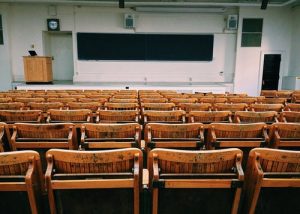 The American Society of Civil Engineers’ 2021 Infrastructure Report Card gave the United States’ public school building stock (K-12) a D+–the same grade garnered in 2017. With many buildings aging past fifty years, vital facility repairs are many and corrective dollars are often few. With accounts of decay ranging from eroding floors and crumbling walls to HVAC systems that deliver poor ventilation and uncomfortable temperatures, it seems a miracle is in order if we want our public school system to offer a sound, modern education.
The American Society of Civil Engineers’ 2021 Infrastructure Report Card gave the United States’ public school building stock (K-12) a D+–the same grade garnered in 2017. With many buildings aging past fifty years, vital facility repairs are many and corrective dollars are often few. With accounts of decay ranging from eroding floors and crumbling walls to HVAC systems that deliver poor ventilation and uncomfortable temperatures, it seems a miracle is in order if we want our public school system to offer a sound, modern education.
Funds for building a modern school system.
Chalk it up to chaos theory (because nobody in their right mind would label the Covid pandemic a miracle or a Hail Mary), but U.S. school districts suddenly have an opportunity to tackle building and preparedness deficits made even more apparent by the pandemic. A $122 billion share of the $1.9 trillion American Rescue Plan law (March 2021) has been allocated to school districts for modernizing facilities, making buildings safer, purchasing technology, and helping students catch up on learning missed during school closures. Degrees of flexibility are built into the parameters for fund use, thereby catering to the unique needs of each district. In other words: This is the time for many districts to prep infrastructure for the future.
Many schools need to upgrade HVAC systems.
The U.S. Department of Education advises districts to consider investing part of their new funds in Ventilation and Indoor Air Quality (IAQ) upgrades. The department notes, “Indoor air quality improvements are critical for creating healthier indoor learning environments not only to safely reopen schools, but also to keep them open and ensure the sustained health and productivity of students, teachers, and staff.”
Such an unprecedented U.S. investment in schools, which many feel was a long time coming, is a fantastic albeit hard-won opportunity for our nation’s future. And turning facilities into clean energy users and producers checks multiple boxes:
- Healthier school communities: Superior ventilation and IAQ reduce sick days for students and staff. The hope is that it will also help keep our schools open amid whatever variant arises next. In the interest of preparedness, it’s also a good idea to introduce UV germicidal sanitizers to HVAC systems and to invest in portable electrostatic air cleaners.
- More productive learning: Studies claim healthy IAQ improves cognition for better human performance in any facility. In addition, the thermal comfort achieved with superior HVAC systems reduces classroom fidgeting and sleepiness that can result from too much heat, cold, and/or humidity.
- An education for the future: Clean energy HVAC can create net-zero or net-power-producing buildings! The resulting lowered utility bills can free up funds for hiring more staff, upgrading technology, and/or offering new student services.
- Green buildings fight climate change: Since building stock, in general, is responsible for 40% of greenhouse gas emissions, switching to clean energy systems makes U.S. schools part of the solution.
You could say we’re ‘retroactive’!
Is your local school district making sound decisions over its share of the ARP? Do the facilities need a serious clean energy retrofit? You might want to make your voice heard at school board meetings.
Such retrofits are the projects Haglid EngineeringTM and Building Performance Equipment, Inc. get extra excited about. Why? It doesn’t get much better than spending the workday doing your part to reduce emissions for the sake of the planet while increasing the well-being of future generations.
Haglid Engineering has helped many districts to ‘green-up’ their schools and excels in meeting ENERGY STAR® and LEED standards. (For example, check out our Hunterdon Regional High School, NJ and Hopewell Valley Regional District, NJ case studies.) Depending on the facility’s needs, we’ve run energy audits and modeling before pinpointing solutions such as solar energy systems, building envelope adjustments, designing high-efficiency HVAC, configuring lighting systems, and introducing Building Management Systems (BMS).
At the heart of HVAC solutions, BPE Energy Recovery Ventilators (ERVs) are used to achieve up to 90% thermal efficiency, up to 34% latent effectiveness, and Energy Efficiency Ratings of 36 to 160 (industry standard is 10). BPE products are as versatile as your facility’s unique needs.
Is your school district wondering how to spend its ARP funds and doesn’t know where to start? Haglid Engineering is at your service. Give us a call to experience proven solutions and a passion for what we do.
